Landscaping with evergreens: 12 ways to make an impact with your planting
These expert ideas for landscaping with evergreens reveal the best ways to use this crucial element of garden design
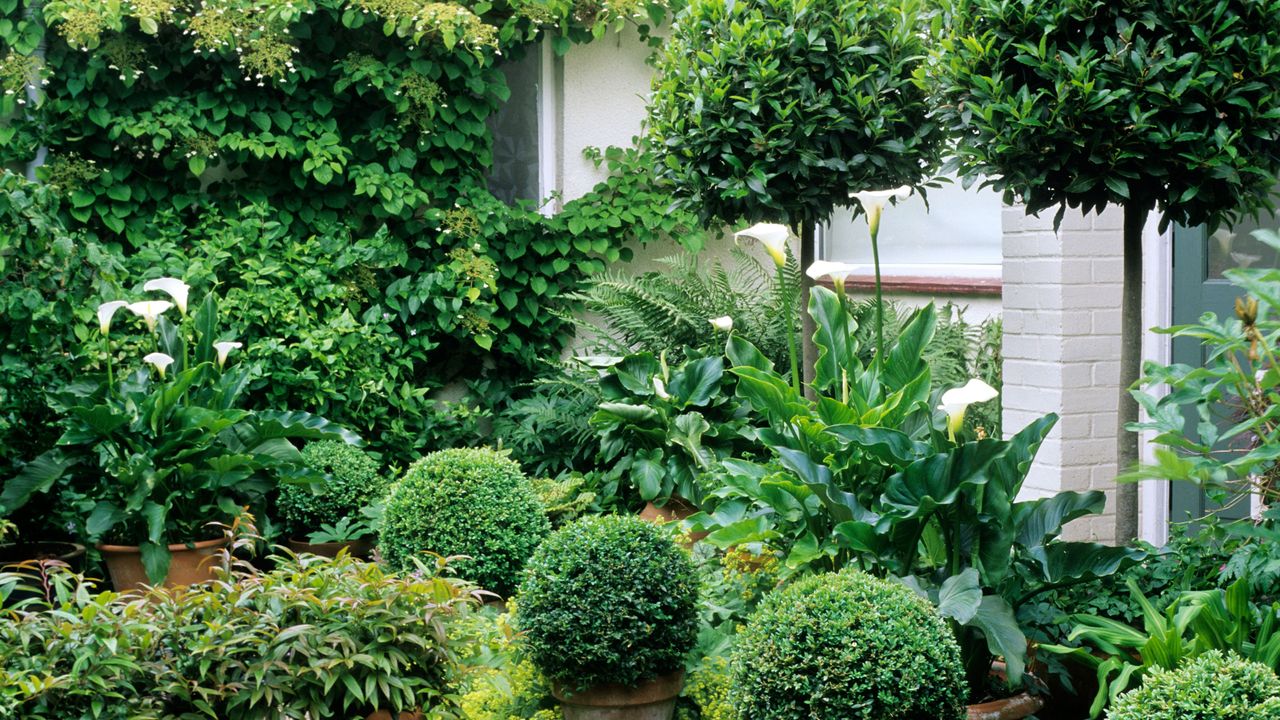

Every garden should include some clever ideas for landscaping with evergreens as they're the most hardworking shrubs and trees that will really earn their place in your scheme. They add year-round interest and structure, which makes them especially important over winter. They are generally a low maintenance option too.
As well as lush green foliage some varieties add color with beautiful blooms and berries, while others are highly scented, so they contribute far more than simply lush, reliable and good looking foliage. Whether you decide to mix them in with your planting or let them be the main focal point, you won't be disappointed with the results.
Structural evergreens form the backbone of the garden, providing a framework that will let other plants shine. Find out how to get the look with our expert tips for landscaping ideas that will take centre stage in your garden for years to come.
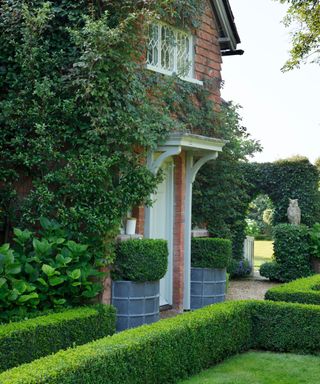
Try adding some curb appeal to your front yard with smartly clipped low hedges and a pair of symmetrical planters flagging the porch
12 ideas for landscaping with evergreens that are approved by experts
Garden designers love landscaping with shrubs and especially those that are evergreen so they're quick to offer plenty of expert tips on the subject that are super helpful if you're thinking of working a lush green look into your own outdoor space.
'When designing any garden, you want a high percentage of evergreen plants that hold their structure through the winter,' says award winning garden designer Kate Gould. 'Ideally, 50-70 per cent of the planting would be evergreen. Happily they require the least amount of maintenance too.'
By nature, evergreens are often quite dense, which also makes them a great choice for topiary too. 'Ensuring there is a balance in the planting design is key to letting evergreens shine,' adds Kate. 'That said, if you really want to go for it then opt for an all-evergreen garden with lots of clipped shapes that contrast with each other. It is a bold move but one that will look timeless.'
Our round-up of inspirational expert ideas show how to do landscaping with evergreens so you can get the most professional looking results.
1. Zone a seating area with evergreens
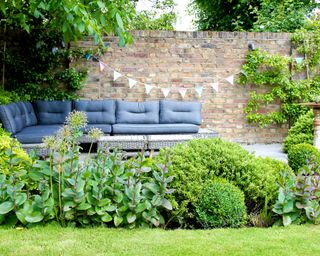
This garden project by Fiona Lamb Design includes a mix of evergreen planting
Evergreens are a hugely important consideration for most gardens. They provide essential, year round structure, ensuring that there is interest in the garden even in midwinter. They are the backdrop against which everything else can perform as perennials, annuals and ornamental grasses will all benefit from an evergreen foil.
'Evergreens can provide privacy and are a useful way of dividing up a garden naturally without the need for walls or fences,' says garden designer Fiona Lamb. 'Domes of evergreen foliage in this outdoor seating area are interspersed with perennials to give seasonal color and interest.' The evergreen planting helps to define a softly delineated space too.
2. Use evergreens to create structure in a space
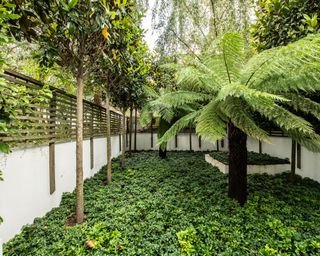
Evergreens can be used to create a more structured space, as in this urban garden by Bowles & Wyer
Consider using evergreens if you have a small urban garden and want to create eye-catching, minimalist, low-maintenance landscaping ideas in the heart of the city.
In this design a mix of structured pleached trees contrasts with the soft wavy fronds of a tree fern, both adding differing points of vertical interest to the space.
'This dense planting scheme includes evergreen Magnolia grandiflora around the perimeter of the garden and the semi-evergreen tree fern Dicksonia antartica. The ground cover planting is Pachysandra terminalis,' explains landscape designer John Wyer, CEO of Bowles & Wyer.
Also known as Japanese spurge, Pachysandra terminalis is a mat-forming evergreen perennial in the boxwood family. This dwarf shrub is popular as it spreads into a dense evergreen carpet beneath other taller shrubs and thrives in dry shade.
Ferns are another good choice as they add lush greenery, are easy to look after and most of them look good all year round too.
3. Plant up oversized pots with evergreens
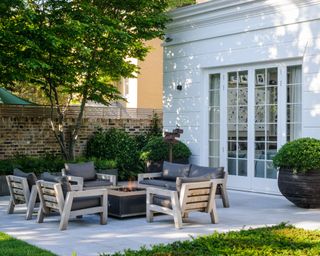
Create statement focal points with oversized planters, as shown in this garden design by Harris Bugg Studio
Landscaping with evergreens is a great way to provide year round structure and winter interest as well as adding a strong form in the garden. Taking your evergreens right up to the house means you can enjoy them throughout the seasons as it lets you look out on deep green foliage right through winter.
This stylish, contemporary year-round entertaining garden by Harris Bugg Studio is a green and peaceful escape from the outside world. A rich tapestry of textural planting includes clipped evergreen yew squares to inject breathing space and create a darker foil to the other planting.
Oversized garden planters sit on the fossilised sandstone paving that forms the terrace. They are planted up with shapely mounds of Pittosporum tobira ‘Nanum’. This is a popular small, dense, slow-growing, evergreen shrub loved by garden designers that reaches a height of about 3ft (1m) with glossy leaves and sweetly scented flowers in late spring and early summer. It's a must to include in your evergreen planting ideas.
4. Layer up planting to build the look
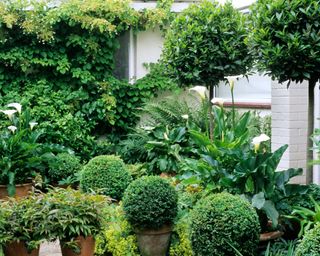
Evergreen planting will provide year-round interest in your plot
Using a series of soft billowing evergreen forms helps to blur the edges of the garden and layer up a lush look all year round. You will soon find your favorite go-to varieties for landscaping with evergreens and start to use them for repeat planting to get a professional-looking finish.
The addition of cool white Calla lilies (Zantedeschia) such as in this design shows how landscaping with flowers can lighten a dark evergreen planting scheme too.
'Evergreen plants are useful for adding structure to a garden, acting as a foil for herbaceous plants, and creating a display that will really catch the eye,' says John Wyer, CEO of Bowles & Wyer. John has several favorite evergreens that he returns to time and again.
'Evergreens play an important role and there are some that we use regularly in our designs, such as Trachelospermum jasminoides (star jasmine) and Liriope (lily turf) for example. The indestructible Griselinia littoralis (New Zealand broad leaf) is also be a good choice, particularly for a roof terrace or coastal garden.'
If you live by the ocean you'll want to know the best coastal plants that are evergreen and will thrive in these conditions. Even if you live miles from the sea many of the same plants will also flourish in your garden so it's well worth taking a look.
5. Learn to love small evergreen varieties
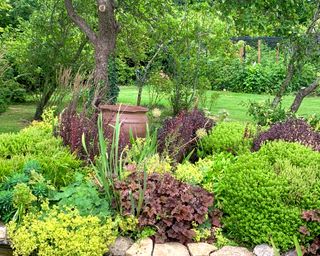
Evergreens play a key role in the planting scheme of this garden by Fiona Lamb
If the idea of low-growing evergreens is appealing to your garden design ideas you're in the right place for expert recommendations.
'Make Hebe rakiensis a regular in your evergreen planting,' suggests garden designer Fiona Lamb. 'Its neat shape and apple green brightness look great repeated through planting beds or for edging steps.'
Fiona is a big fan of Pittosporums too. 'Another of my go-to plants are Pittosporums, and especially Pittosporum tenuifolium ‘Tom Thumb’ whose purple leaves can give fantastic contrast when surrounded by green plants.'
Pittosporums are another reliable evergreen that's available in a variety of forms from large species like Pittosporum tenuifolium ‘Silver Queen’ that can be used as a statement plant to the low growing compact form Pittosporum tobira nanum which we mentioned earlier.
6. Create a more formal look
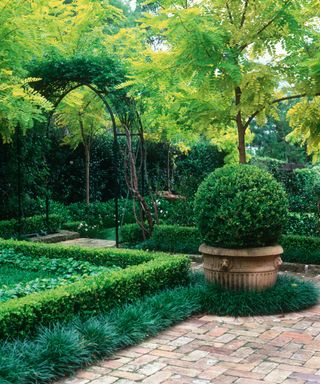
Low clipped hedges will create a smart, formal look in a space
Structural blocks of low clipped hedging punctuated by decorative potted domes here and there shows how landscaping with evergreens can create a smart geometrical look. The evergreens in this design are very much the stars of the show rather than acting as a backdrop.
Alongside the vertical element of the trees, and the textural and floral displays of grasses and perennials, lines of low hedging plants can be used to soften boundaries and accentuate the division between spaces.
Clipped evergreens like yew, box and holly make a wonderful foil for looser planting around them. In winter they come into their own, as the herbaceous planting recedes to reveal their form and the structural bones of the garden.
7. Introduce some evergreen topiary to your garden
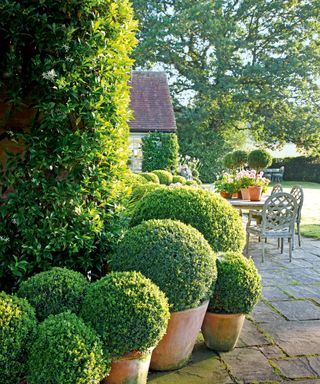
Add height, texture and structure to a patio with clipped evergreens in pots
In grand country gardens topiary has been used for centuries as a design feature of landscaping with evergreens, but you can use the same technique of creating sculptural form in small gardens with great results. Clipped evergreens add architectural form and become a focal point, especially when sculpted into smart or whimsical shapes.
Eye-catching topiary is a way of adding drama, using the clipped foliage of larger shrubs to create strong punctuation marks within your planting scheme.
Smaller evergreen plants such as hebe are one of the best plants for small gardens and can be clipped into mounds to provide form, color and texture at a lower level. These work well for enhancing edges, softening level changes, dividing connected spaces, or filling up planters for year-round interest. They are a great choice for cheap landscaping ideas too as they're not an expensive plant choice.
A display of pots planted up with clipped foliage always makes an eye-catching addition to any outdoor space, however small.
8. Edge paving with evergreens in natural clusters
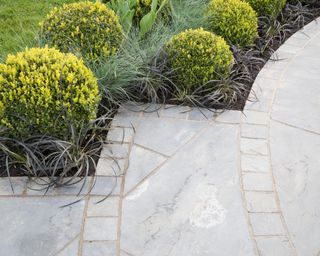
Evergreens are a great way to soften the impact of hard landscaping
Position your chosen evergreen plants in natural clusters and allow low evergreens to spill over onto garden paths and pavers. Avoid a look that is too evenly spaced with evergreens of a uniform size, and instead create different sized clusters to create natural rhythm in your garden edging ideas.
It's a great idea to rough out your evergreen planting positions by arranging the plants while still in their pots and shifting them around to get the best layout before stepping back and taking an overview to check the balance works with your paving ideas.
Box (Buxus sempervirens) balls are a superb choice for topiary. They need well-drained soil so use good compost, bark mulch and grit, and water regularly over summer. Mix in some landscaping with grasses for textural contrast.
9. Work up a modern look with evergreens
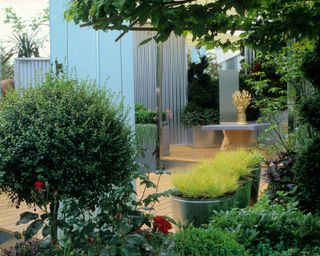
This garden by landscape architect Stephen Woodhams shows how evergreens can be used to create a contemporary planting scheme
Plant evergreens in steel containers against a backdrop of cool color and you instantly create a very different look from classic topiary styles that feels modern and contemporary, such as in this award-winning garden by landscape architect Stephen Woodhams.
Evergreens give year-round interest and form while soft perennials rise and fall around them to provide more unstructured seasonal change, movement and interest. Try going for a looser, less clipped look for the evergreens.
Perennials that work well with evergreen planting include Thalictrum and Verbena bonariensis, which will rise up through structural planting to add height. Underplant and soften evergreen shrubs with low creeping ground cover plants like Geranium ‘Rozanne’ and Alchemilla mollis. There are lots of evergreen perennials to choose from too.
10. Factor in evergreens from the get-go
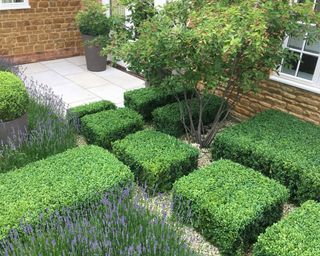
Low evergreen hedges are a great choice for a more formal front garden. Garden design by Lee Bestall
'For almost six months of the year the garden relies on evergreens for structure and form,' says garden designer Lee Bestall. 'When designing a garden, it’s important to think how the garden will look in winter. Often referred to as the bones of the garden, the evergreen structure should be the starting point once the initial layout of the garden has been decided.'
Plants such as Taxus and Buxus are timeless classics, both responding well to regular clipping, offering structure and mass in formally clipped hedges and topiary.
Why not consider doing something a little different with them like creating a set of smart clipped cube shapes to create a real design feature and add distinctive curb appeal to your front yard landscaping ideas? This is a look that works brilliantly in gravel gardens or when landscaping with lavender for a look that's easy to do, looks good all year and is low maintenance too.
11. Opt for easy blocks of evergreens
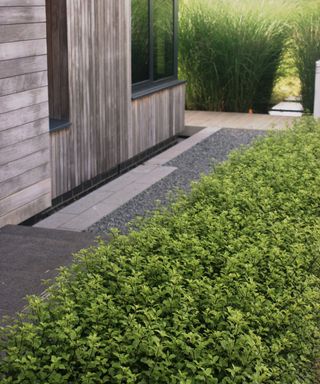
In this garden design by Rae Wilkinson, ornamental grasses make an ideal planting partner for evergreen shrubs
In this garden design by Rae Wilkinson, evergreen hedges combine with ornamental grasses to divide spaces with blocks of varying texture. 'A large portion of the structure within gardens should be provided by the planting,' says Rae. 'When herbaceous plants die back in the winter and deciduous leaves fall, the evergreen structure retains the green element and defines the space.'
When it comes to hedges, evergreens are effective year-round garden screening ideas, but remember they can cast gloomy shade in winter. In addition to acting as boundaries, hedges can also be used within the garden to frame a view or to block out something you don't want to be seen, such as a shed. Shrubs used to form a low hedge in a garden border helps to create a visual reference point.
12. Style up your deck with evergreen planters
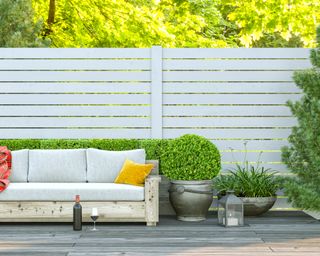
Add interest to a decked seating area with potted evergreens
Be sure to include pots of smartly clipped evergreen plants as part of your decking ideas. They often get overlooked in favor of more colorful container gardening ideas but they really do hold their own for a smart and low maintenance look that keeps on giving.
What can I plant next to evergreens?
When it comes to what to plant next to evergreens the good news is that they are super companionable shrubs happy to mingle with lots of other plants so you can pretty much take your pick.
One of the favorite companion plants when landscaping with evergreens are ornamental grasses, many of which are evergreen themselves and offer year round continuity. Some good types of ornamental grass to try include varieties of Festuca and Carex.
Ferns, herbaceous perennials and bulbs all work well planted with evergreens. Use a few taller perennials such as sedums, Japanese anemones and euphorbia to fill the empty spaces between evergreens and contribute extra color.
Evergreen perennials like Bergenia, Erysimum ‘Bowles’s Mauve’ and heuchera are also a good bet as they spread quickly to cover any gaps in your planting and work well as low maintenance flower bed ideas.
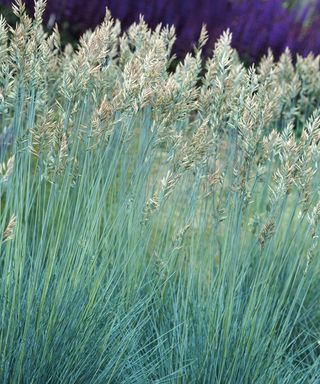
The ornamental grass Festuca glauca 'Intense Blue' is a great choice to plant with evergreens

Lifestyle journalist Sarah Wilson has been writing about gardens since 2015. She's written for Gardeningetc.com, Livingetc, Homes & Gardens, Easy Gardens and Modern Gardens magazines. Having studied introductory garden and landscape design, she is currently putting the skills learned to good use in her own space where the dream is establishing a cutting garden.
